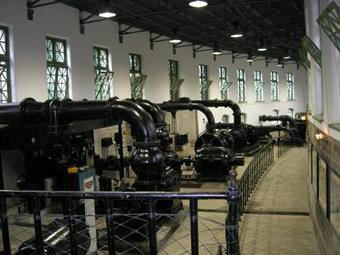自來水博物館-歷史 Museum of Drinking Water-History

臺北市現代化的自來水設施始於日治初期。明治二十八年(1895年),日本接管臺灣,為改善臺北的衛生條件,即開始規劃自來水的供水系統。並聘雇英人威廉.巴爾頓來臺進行全臺衛生工程的調查工作。
明治四十年(1907年),根據巴爾頓建議,在公館小觀音山山腳下的新店溪畔設置取水口,抽水至小觀音山的淨水場。然後用抽水機將淨化後的水抽至山頂的蓄水池,藉由重力流方式供應臺北市的用水。「臺北水道水源地唧筒室」是當時放置抽水機的機房,民國六十六年(1977年),新店溪下游汙染日益嚴重,於是取水口移至上游的青潭堰,唧筒室才功成身退,後演變成為今日的「自來水博物館」。
The original "Taipei Water Source Site Pumping Room" was built in 1908, when Taiwan was ruled by Japan. The birth of Taipei City's modern drinking-water facilities was in 1895, when Japan took over Taiwan. In order to improve the city's sanitary conditions, the Japanese government began to map out waterworks for drinking water and commissioned a Scotsman, William K. Burton, to conduct a survey of Taiwan's sanitary engineering. Based on Burton's suggestion, a water-intake unit was established in 1907 at the foot of Guanyinshan by the Xindian River (Xindianxi) to pump water to the purification plant on Guanyinshan, then pump the treated water upward to the reservoir on the hilltop, and supply water to the city through natural gravitational force. The Taipei Water Source Site Pumping Room where the pumping equipment was placed was retired from service in 1977, when the intake unit was relocated to Qingtan Dam on the upper reaches of Xiandianxi due to increasing pollution on the downstream Xindianxi section. It later became today's Museum of Drinking Water.
